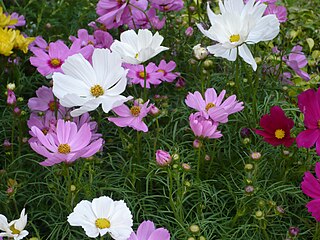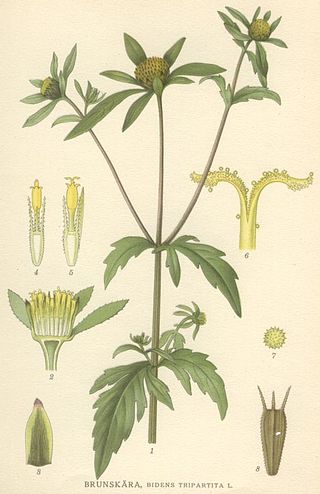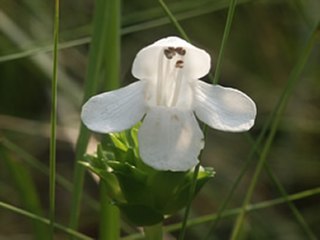
Cosmos is a genus, with the same common name of cosmos, consisting of flowering plants in the sunflower family.

Bidens is a genus of flowering plants in the aster family, Asteraceae. The genus include roughly 230 species which are distributed worldwide. Despite their global distribution, the systematics and taxonomy of the genus has been described as complicated and unorganized. The common names beggarticks, black jack, burr marigolds, cobbler's pegs, Spanish needles, stickseeds, tickseeds and tickseed sunflowers refer to the fruits of the plants, most of which are bristly and barbed. The generic name refers to the same character; Bidens comes from the Latin bis ("two") and dens ("tooth").

Coreopsis is a genus of flowering plants in the family Asteraceae. Common names include calliopsis and tickseed, a name shared with various other plants.

Helianthus is a genus comprising about 70 species of annual and perennial flowering plants in the daisy family Asteraceae commonly known as sunflowers. Except for three South American species, the species of Helianthus are native to North America and Central America. The best-known species is the common sunflower. This and other species, notably Jerusalem artichoke, are cultivated in temperate regions and some tropical regions, as food crops for humans, cattle, and poultry, and as ornamental plants. The species H. annuus typically grows during the summer and into early fall, with the peak growth season being mid-summer.

Sarracenia rubra, also known as the sweet or purple pitcher plant, is a carnivorous plant in the genus Sarracenia. Like all Sarracenia, it is native to the New World. Its range extends from southern Mississippi, through southern Alabama, the Florida panhandle and Georgia, to the coastal plains of North Carolina and South Carolina.

Tageteae is a tribe of the plant family Asteraceae. It consists of approximately 260 species divided among 32 genera. All are found in the New World, with a center of diversity in the Mexican highlands. The type genus is Tagetes (marigolds).

Neviusia alabamensis, the Alabama snow-wreath, is a small shrub which is native to the Southeastern United States.
Ericentrodea is a genus of South American flowering plants in the family Asteraceae.
Pappobolus is a genus of flowering plant in the family Asteraceae native to the Andes Mountains of Colombia, Ecuador, and Peru.

Sarracenia alabamensis, also known as the cane-brake pitcher plant, is a carnivorous plant in the genus Sarracenia. Like all Sarracenia, it is native to the New World. S. alabamensis subsp. alabamensis is found only in central Alabama, while subsp. wherryi is found in southwestern Alabama, eastern Mississippi and Florida. It is sometimes treated as two subspecies of S. rubra.

Thelesperma is a genus of North American and South American plants in the cosmos tribe within the sunflower family. Greenthread is a common name for plants in this genus.

Heterosperma is a genus of flowering plants in the sunflower family, native to North and South America.

Melanthera, is a genus of perennial flowering plants in the family Asteraceae, native to North and South America, as well as Africa, Asia and Oceania, including Hawaiʻi.
Narvalina is a genus of flowering plants in the dahlia tribe within the sunflower family.
Phoebanthus, called false sunflower, is a genus of North American plants in the tribe Heliantheae within the family Asteraceae.
Coreocarpus is a genus of flowering plants in the family Asteraceae native to northwestern Mexico and southern Arizona.

Macbridea is a small genus of plants in the family Lamiaceae, first described in 1818. It is native to the southeastern United States.
Coreocarpus arizonicus, the little lemonhead, is a North American species of flowering plants in the daisy family native to northwestern Mexico and the southwestern United States. It has been found in southern Arizona, and in the adjacent Mexican States of Sonora, Chihuahua, Sinaloa, and Baja California Sur.

Prunus alabamensis, the Alabama cherry or Alabama black cherry, is an uncommon or rare species of tree in the rose family endemic to parts of the Southeastern United States. It occurs in the states of Alabama, Florida, Georgia, Mississippi, and South Carolina. It is closely related to and found wholly within the range of Prunus serotina, the black cherry, a much more common and widespread species of Prunus that is also native to the region. Alabama cherry is sometimes considered to be a variety of Prunus serotina, however most authors treat it as a distinct species.

Myriopteris alabamensis, the Alabama lip fern, is a moderately-sized fern of the United States and Mexico, a member of the family Pteridaceae. Unlike many members of its genus, its leaves have a few hairs on upper and lower surfaces, or lack them entirely. One of the cheilanthoid ferns, it was usually classified in the genus Cheilanthes as Cheilanthes alabamensis until 2013, when the genus Myriopteris was again recognized as separate from Cheilanthes. It typically grows in shade on limestone outcrops.














